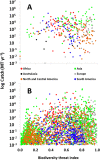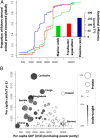Linking freshwater fishery management to global food security and biodiversity conservation
- PMID: 27791055
- PMCID: PMC5111672
- DOI: 10.1073/pnas.1521540113
Linking freshwater fishery management to global food security and biodiversity conservation
Abstract
Fisheries are an essential ecosystem service, but catches from freshwaters are often overlooked. Hundreds of millions of people around the world benefit from low-cost protein, recreation, and commerce provided by freshwater fisheries, particularly in regions where alternative sources of nutrition and employment are scarce. Here, we derive a gridded global map of riverine fisheries and assess its implications for biodiversity conservation, fishery sustainability, and food security. Catches increase with river discharge and human population density, and 90% of global catch comes from river basins with above-average stress levels. Fish richness and catches are positively but not causally correlated, revealing that fishing pressure is most intense in rivers where potential impacts on biodiversity are highest. Merging our catch analysis with nutritional and socioeconomic data, we find that freshwater fisheries provide the equivalent of all dietary animal protein for 158 million people. Poor and undernourished populations are particularly reliant on inland fisheries compared with marine or aquaculture sources. The spatial coincidence of productive freshwater fisheries and low food security highlights the critical role of rivers and lakes in providing locally sourced, low-cost protein. At the same time, intensive fishing in regions where rivers are already degraded by other stressors may undermine efforts to conserve biodiversity. This syndrome of poverty, nutritional deficiency, fishery dependence, and extrinsic threats to biodiverse river ecosystems underscores the high stakes for improving fishery management. Our enhanced spatial data on estimated catches can facilitate the inclusion of inland fisheries in environmental planning to protect both food security and species diversity.
Keywords: ecosystem services; fish diversity; fishing pressure; rivers; subsistence fishery.
Conflict of interest statement
The authors declare no conflict of interest.
Figures








References
-
- Palmer MA, Febria CM. Ecology. The heartbeat of ecosystems. Science. 2012;336(6087):1393–1394. - PubMed
-
- Tittensor DP, et al. A mid-term analysis of progress toward international biodiversity targets. Science. 2014;346(6206):241–244. - PubMed
-
- Larsen FW, Londoño-Murcia MC, Turner WR. Global priorities for conservation of threatened species, carbon storage, and freshwater services: Scope for synergy? Conserv Lett. 2011;4(5):355–363.
-
- Vörösmarty CJ, et al. Global threats to human water security and river biodiversity. Nature. 2010;467(7315):555–561. - PubMed
-
- Strayer DL, Dudgeon D. Freshwater biodiversity conservation: Recent progress and future challenges. J N Am Benthol Soc. 2010;29(1):344–358.
LinkOut - more resources
Full Text Sources
Other Literature Sources

